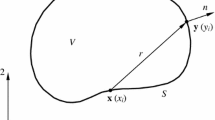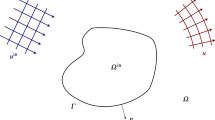Abstract
This paper presents a fast multipole boundary element method (FMBEM) for the 3-D elastodynamic boundary integral equation in the ‘low frequency’ regime. New compact recursion relations for the second-order Cartesian partial derivatives of the spherical basis functions are derived for the expansion of the elastodynamic fundamental solutions. Numerical solution is achieved via a novel combination of a nested outer–inner generalized minimum residual (GMRES) solver and a sparse approximate inverse preconditioner. Additionally translation stencils are newly applied to the elastodynamic FMBEM and an implementation of the 8, 4 and 2-box stencils is presented, which is shown to reduce the number of translations per octree level by up to \(60\,\%\). This combination of strategies converges 2–2.5 times faster than the standard GMRES solution of the FMBEM. Numerical examples demonstrate the algorithmic and memory complexities of the model, which are shown to be in good agreement with the theoretical predictions.
















Similar content being viewed by others
References
Liu YJ, Mukherjee S, Nishimura N, Schanz M, Ye W, Sutradhar A, Pan E, Dumont NA, Frangi A, Saez A (2011) Recent advances and emerging applications of the boundary element method. Appl Mech Rev 64:1–38
Cruse TA, Rizzo FJ (1968) A direct formulation and numerical solution of the general transient elastodynamic problem. I. J Math Anal Appl 22:244–259
Cruse TA, Rizzo FJ (1968) A direct formulation and numerical solution of the general transient elastodynamic problem. II. J Math Anal Appl 22:341–355
Beskos DE (1987) Boundary element methods in dynamic analysis. Appl Mech Rev 40:1–23
Beskos DE (1997) Boundary element methods in dynamic analysis: part II. Appl Mech Rev 50:149–197
Eringen AC, Suhubi ES (1975) Elastodynamics. Academic Press, New York
Beskos DE, Manolis GD (1987) Boundary element methods in elastodynamics. Allen and Unwin, London
Bonnet M (1995) Boundary integral equation methods for solids and fluids. Wiley, Chichester
Beskos DE (2003) Dynamic analysis of structures and structural systems. In: Beskos D, Maier G (eds) Boundary element advances in solid mechanics. Springer, New York
Rokhlin V (1985) Rapid solution of integral equations of classical potential theory. J Comput Phys 60:187–207
Greengard L, Rokhlin V (1987) A fast algorithm for particle simulations. J Comput Phys 73(325):348
Nishimura N (2002) Fast multipole accelerated boundary integral equation methods. Appl Mech Rev 55:299–324
Chen YH, Chew WC, Zeroug S (1997) Fast multipole methods as an efficient solver for 2D elastic wave surface integral equations. Comput Mech 20:495–506
Rokhlin V (1993) Diagonal forms of translation operators for the Helmholtz equation in three dimensions. Appl Comput Harmon Anal 1:82–93
Fukui T, Inoue K (1998) Fast multipole boundary element method in 2D elastodynamics (in Japanese). J Appl Mech JSCE 1:373–380
Fujiwara H (1998) The fast multipole method for integral equations of seismic scattering problems. Geophys J Int 133:773–782
Fujiwara H (2000) A fast multipole method for solving integral equations of three-dimensional topography and basin problems. Geophys J Int 140:198–210
Yoshida K, Nishimura N, Kobayashi S (2000) Analysis of three dimensional scattering of elastic waves by a crack with fast multipole boundary integral equation method (in Japanese). J Appl Mech JSCE 3:143–150
Shen L, Liu YJ (2007) An adaptive fast multipole boundary element method for three-dimensional acoustic wave problems based on the Burton-Miller formulation. Comput Mech 40:461–472
Yoshida K, Nishimura N, Kobayashi S (2001) Applications of a diagonal form fast multipole BIEM to the analysis of three dimensional scattering of elastic waves by cracks. Trans JASCOME, J BEM 18:77–80
Isakari H, Yoshikawa H, Nishimura N (2010) A periodic FMM for elastodynamics in 3D and its applications to problems related to waves scattered by a doubly periodic layer of scatterers (in Japanese). J Appl Mech JSCE 13:169–178
Gumerov NA, Duraiswami R (2004) Fast multipole methods for the Helmholtz equation in three dimensions. Elsevier, Oxford
Chaillat S, Bonnet M, Semblat JF (2008) A multi-level fast multipole BEM for 3-D elastodynamics in the frequency domain. Comp Meth Appl Mech Eng 197:4233–4249
Sanz JA, Bonnet M, Dominguez J (2008) Fast multipole method applied to 3-D frequency domain elastodynamics. Eng Anal Bound Elem 32:787–795
Chaillat S, Semblat JF, Bonnet M (2012) A preconditioned 3-D multi-region fast multipole solver for seismic wave propagation in complex geometries. Commun Comput Phys 11:594–609
Gumerov NA, Duraiswami R (2009) A broadband fast multipole accelerated boundary element method for the 3D Helmholtz equation. J Acoust Soc Am 125:191–205
Chaillat S, Bonnet M, Semblat JF (2009) A new fast multi-domain BEM to model seismic wave propagation and amplification in 3-D geological structures. Geophys J Int 177:509–531
Tong MS, Chew WC (2009) Multilevel fast multipole algorithm for elastic wave scattering by large three-dimensional objects. J Comput Phys 228:921–932
Isakari H, Ninno K, Yoshikawa H, Nishimura N (2012) Calderon’s preconditioning for periodic fast multipole method for elastodynamics in 3D. Int J Numer Methods Eng 90:484–505
Grasso E, Chaillat S, Bonnet M, Semblat JF (2012) Application of the multi-level time-harmonic fast multipole BEM to 3-D visco-elastodynamics. Eng Anal Bound Elem 36:744–758
Chaillat S, Bonnet M (2014) A new fast multipole formulation for the elastodynamic half-space Green’s tensor. J Comput Phys 258:787–808
Takahashi T (2012) A wideband fast multipole accelerated boundary integral equation method for time-harmonic elastodynamics in two dimensions. Int J Numer Methods Eng 91:531–551
Chaillat S, Bonnet M (2013) Recent advances on the fast multipole accelerated boundary element method for 3D time-harmonic elastodynamics. Wave Motion 50:1090–1104
Benedetti I, Aliabadi MH (2010) A fast hierarchical dual boundary element method for three-dimensional elastodynamic crack problems. Int J Numer Methods Eng 84:1038–1067
Xiao J, Ye W, Wen L (2013) Efficiency improvement of the frequency-domain BEM for rapid transient elastodynamic analysis. Comput Mech 52:903–912
Ergül Ö, Gürel L (2010) Efficient solutions of metamaterial problems using a low-frequency multilevel fast multipole algorithm. PIER 108:81–99
Chaillat S (2008) Fast multipole method for 3-D elastodynamic boundary integral equations. Application to seismic wave propagation. Dissertation, Ecole Polytechnique
Gumerov NA, Duraiswami R (2003) Recursions for the computation of multipole translation and rotation coefficients for the 3-D Helmholtz equation. SIAM J Sci Comput 25:1344–1381
Gumerov NA, Duraiswami R (2008) Fast multipole methods on graphics processors. J Comput Phys 227:8290–8313
Liu J, Yu C, Chen Y, Li X (2008) Computational formulations for the fundamental solution and kernal functions of elasto-plastic FM-BEM in spherical coordinate system. ICIC-EL 2:207–212
Rathod HT, Nagaraja KV, Ventatesudu B, Ramesh NL (2004) Gauss Legendre quadrature over a triangle. J. Indian Inst. Sci 84:183–188
Scuderi L (2008) On the computation of nearly singular Integrals in 3D BEM collocation. Int J Numer Methods Eng 74:1733–1770
Wu TW (2000) The Helmholtz integral equation. In: Wu T (ed) Boundary element acoustics: fundamentals and computer codes. WIT Press, Great Britain
Dangla P, Semblat JF, Xiao H, Delepine N (2005) A simple and efficient regularization method for 3D BEM: application to frequency-domain elastodynamics. B Seismol Soc Am 95:1916–1927
Saad Y (1993) A flexible inner–outer preconditioned GMRES algorithm. SIAM J Sci Comput 14:461–469
Chen K, Harris PJ (2001) Efficient preconditioners for iterative solution of the boundary element equations for the three-dimensional Helmholtz equation. Appl Numer Math 36:475–489
Darbas M, Darrigrand E, Lafranche Y (2013) Combining analytic preconditioner and fast multipole method for the 3-D Helmholtz equation. J Comput Phys 236:289–316
Ying CF, Truell R (1956) Scattering of a plane longitudinal wave by a spherical obstacle in an isotropically elastic solid. J Appl Phys 27:1086–1097
Jones DS (1985) Boundary integrals in elastodynamics. IMA J Appl Math 34:83–97
Reinoso E, Wrobel LC, Power H (1997) Three-dimensional scattering of seismic waves from topographical structures. Soil Dyn Earthq Eng 16:41–61
Acknowledgments
This work was supported by an APA scholarship, funded by the Australian government.
Author information
Authors and Affiliations
Corresponding author
Appendix: Recurrence relations for the second-order partial derivatives of S and R
Appendix: Recurrence relations for the second-order partial derivatives of S and R
The multipole expansion of the elastodynamic fundamental solutions (Eqs. 2 and 3) requires the evaluation of first and second-order Cartesian partial derivatives of the spherical basis functions. A direct evaluation of these terms leads to cumbersome expressions [40]. Alternatively, Gumerov and Duraiswami derived compact recurrence relations for the first-order partial derivatives of the S and R spherical basis functions via the following differential operators [38]:
which are exactly expressible in the spherical coordinate system [22]. The x and y first-order partial derivatives are then:
Applying the above differential operators to the spherical basis functions (with \(F_n^m = S_n^m(\mathbf{r}), R_n^m(\mathbf{r})\) for arbitrary expansion vector \(\mathbf{r}\)) yields the following recurrence relations [22, 38]:
with the coefficients \(a_n^m\) and \(b_n^m\) defined as:
New recurrence relations for the second-order partial derivatives of S and R are derived using the following second-order differential operators, which again may be exactly expressed in the spherical coordinate system:
where the unique second-order partial derivatives may be separated as:
The recurrence relations for the second-order differential operators (Eqs. 51–56) for both spherical basis functions (\(F_n^m = S_n^m(\mathbf{r}), R_n^m(\mathbf{r})\)) can then be written as:
Rights and permissions
About this article
Cite this article
Wilkes, D.R., Duncan, A.J. A low frequency elastodynamic fast multipole boundary element method in three dimensions. Comput Mech 56, 829–848 (2015). https://doi.org/10.1007/s00466-015-1205-7
Received:
Accepted:
Published:
Issue Date:
DOI: https://doi.org/10.1007/s00466-015-1205-7




